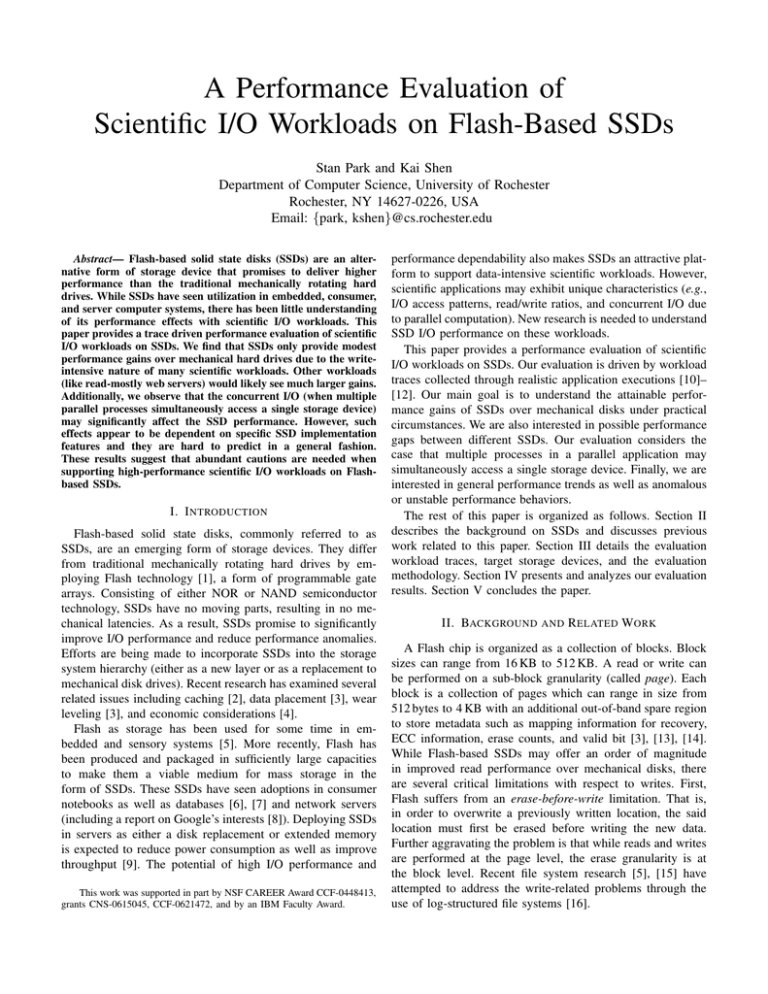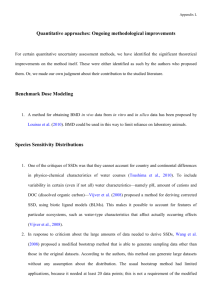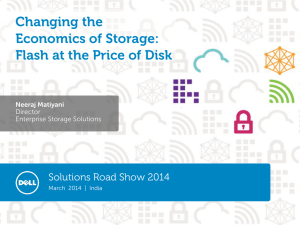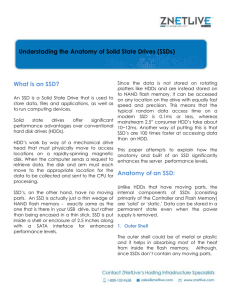A Performance Evaluation of Scientific I/O Workloads on Flash-Based SSDs
advertisement

A Performance Evaluation of
Scientific I/O Workloads on Flash-Based SSDs
Stan Park and Kai Shen
Department of Computer Science, University of Rochester
Rochester, NY 14627-0226, USA
Email: {park, kshen}@cs.rochester.edu
Abstract— Flash-based solid state disks (SSDs) are an alternative form of storage device that promises to deliver higher
performance than the traditional mechanically rotating hard
drives. While SSDs have seen utilization in embedded, consumer,
and server computer systems, there has been little understanding
of its performance effects with scientific I/O workloads. This
paper provides a trace driven performance evaluation of scientific
I/O workloads on SSDs. We find that SSDs only provide modest
performance gains over mechanical hard drives due to the writeintensive nature of many scientific workloads. Other workloads
(like read-mostly web servers) would likely see much larger gains.
Additionally, we observe that the concurrent I/O (when multiple
parallel processes simultaneously access a single storage device)
may significantly affect the SSD performance. However, such
effects appear to be dependent on specific SSD implementation
features and they are hard to predict in a general fashion.
These results suggest that abundant cautions are needed when
supporting high-performance scientific I/O workloads on Flashbased SSDs.
I. I NTRODUCTION
Flash-based solid state disks, commonly referred to as
SSDs, are an emerging form of storage devices. They differ
from traditional mechanically rotating hard drives by employing Flash technology [1], a form of programmable gate
arrays. Consisting of either NOR or NAND semiconductor
technology, SSDs have no moving parts, resulting in no mechanical latencies. As a result, SSDs promise to significantly
improve I/O performance and reduce performance anomalies.
Efforts are being made to incorporate SSDs into the storage
system hierarchy (either as a new layer or as a replacement to
mechanical disk drives). Recent research has examined several
related issues including caching [2], data placement [3], wear
leveling [3], and economic considerations [4].
Flash as storage has been used for some time in embedded and sensory systems [5]. More recently, Flash has
been produced and packaged in sufficiently large capacities
to make them a viable medium for mass storage in the
form of SSDs. These SSDs have seen adoptions in consumer
notebooks as well as databases [6], [7] and network servers
(including a report on Google’s interests [8]). Deploying SSDs
in servers as either a disk replacement or extended memory
is expected to reduce power consumption as well as improve
throughput [9]. The potential of high I/O performance and
This work was supported in part by NSF CAREER Award CCF-0448413,
grants CNS-0615045, CCF-0621472, and by an IBM Faculty Award.
performance dependability also makes SSDs an attractive platform to support data-intensive scientific workloads. However,
scientific applications may exhibit unique characteristics (e.g.,
I/O access patterns, read/write ratios, and concurrent I/O due
to parallel computation). New research is needed to understand
SSD I/O performance on these workloads.
This paper provides a performance evaluation of scientific
I/O workloads on SSDs. Our evaluation is driven by workload
traces collected through realistic application executions [10]–
[12]. Our main goal is to understand the attainable performance gains of SSDs over mechanical disks under practical
circumstances. We are also interested in possible performance
gaps between different SSDs. Our evaluation considers the
case that multiple processes in a parallel application may
simultaneously access a single storage device. Finally, we are
interested in general performance trends as well as anomalous
or unstable performance behaviors.
The rest of this paper is organized as follows. Section II
describes the background on SSDs and discusses previous
work related to this paper. Section III details the evaluation
workload traces, target storage devices, and the evaluation
methodology. Section IV presents and analyzes our evaluation
results. Section V concludes the paper.
II. BACKGROUND
AND
R ELATED W ORK
A Flash chip is organized as a collection of blocks. Block
sizes can range from 16 KB to 512 KB. A read or write can
be performed on a sub-block granularity (called page). Each
block is a collection of pages which can range in size from
512 bytes to 4 KB with an additional out-of-band spare region
to store metadata such as mapping information for recovery,
ECC information, erase counts, and valid bit [3], [13], [14].
While Flash-based SSDs may offer an order of magnitude
in improved read performance over mechanical disks, there
are several critical limitations with respect to writes. First,
Flash suffers from an erase-before-write limitation. That is,
in order to overwrite a previously written location, the said
location must first be erased before writing the new data.
Further aggravating the problem is that while reads and writes
are performed at the page level, the erase granularity is at
the block level. Recent file system research [5], [15] have
attempted to address the write-related problems through the
use of log-structured file systems [16].
Depending on the number of voltage levels a particular cell
is capable of holding, Flash-based SSDs are categorized as
single-level cells (SLC) and multi-level cells (MLC). Specifically, a single-level cell is capable of storing one bit of
information while a multi-level cell is capable of storing two
or more bits. MLCs can provide better storage density, but
they have lower lifetimes and performance in comparison to
SLCs [1], [17]. In SLCs, reads and writes can be performed at
speeds of 25 µsecs and 300 µsecs, respectively, while MLCs
take somewhat longer [3], [13]. Lifetimes for SLCs are reported to be anywhere from 100,000 to 1,000,000 erase cycles
while MLC lifetimes are typically an order of magnitude
less [18], [19]. Our evaluation in this paper will involve both
SLC and MLC drives.
Recent research has evaluated the I/O performance characteristics of Flash-based SSDs. Polte et al. compared the
performance of mechanical disks with a variety of consumer
and enterprise SSDs [20] using the IOzone benchmark [21].
Using a set of synthetic benchmarks, Chen et al. examined
the SSD performance characteristics on sequential, random,
and strided access patterns [22]. Synthetic benchmarks with
regular patterns, however, may not capture the full behaviors
of realistic scientific I/O workloads. For instance, a full
application workload may exhibit mixed data access patterns
and read/write operations may be interleaved in a complex
way.
Specifically targeting supercomputing benchmarks, Cohen et al. compared the I/O performance of a Flash SSD
array against a local disk and networked storage [23]. In
particular, they discovered that SSDs’ performance gain with
a mixed read/write graph processing benchmark is much less
than the gain with read-only synthetic workloads. In addition
to confirming this result on our set of workloads, our research
makes the additional contributions of studying the possible
performance gaps between different SSDs and evaluating the
case that multiple processes in a parallel application may
simultaneously access a single storage device.
III. E VALUATION S ETUP AND M ETHODOLOGY
A. Workload Traces
We evaluate the performance of SSDs on scientific I/O
workloads by replaying realistic workload traces. First, we utilized some Los Alamos National Laboratory MPI_IO_TEST
traces [10]. Specifically, we choose N-to-1 non-strided traces
on 32 processes. We utilize two access sizes for evaluation—
64 KB and 1024 KB. We call these two workload traces
LANL-64KB and LANL-1024KB for the rest of this paper. While strided accesses are a common pattern for highperformance computing environments, we chose to not use
the strided traces due to the limitation of our experimental platform. Specifically, without a large storage array, our
experiments focus on the partial application execution on a
single storage device (explained further in Section III-C).
However, strided accesses often occur in files striped across
a storage array, which is not compatible with our evaluation
methodology.
We also employ three I/O workload traces from the Sandia
National Laboratories [11], [12]. The first trace, alegra.2744,
depicts the I/O accesses of a physics simulation problem
generated from Alegra shock and multi-physics family of
codes. The second trace, CTH, is derived from a shock wave
physics computer code. The third trace depicts the Fortran
I/O run of the S3d I/O kernel. We call these three workload
traces Sandia-alegra, Sandia-cth, and Sandia-s3d
respectively.
All I/O traces contain events at the system call level.
For our trace replaying experiments, we screen the traced
events and retain the following system call events that
are relevant to our I/O system performance evaluation—
open, close, read, readv, iread–iowait, write,
writev, iwrite–iowait, lseek, _llseek, lseek64,
and ftruncate.
We analyzed the five I/O workload traces and Table I
lists the observed read/write access patterns. All workload
traces contain a significant amount of writes. In particular,
Sandia-s3d is completely write-dominated. The high write
intensity of many scientific workloads can be probably attributed to the need to store computation results and record
execution statistics. This is quite different from the read-mostly
web server workloads that typically transmit processing results
to users through the network.
Trace
LANL-64KB
LANL-1024KB
Sandia-alegra
Sandia-cth
Sandia-s3d
I/O access pattern
Read
Write
Sequential
Sequential
Sequential
Sequential
Unrecognized pattern
Unrecognized pattern
N/A
Sequential
Read/write
ratio
0.51/0.49
0.50/0.50
0.14/0.86
0.67/0.33
0.00/1.00
TABLE I
F IVE SCIENTIFIC WORKLOAD TRACES AND GENERAL I/O
CHARACTERISTICS .
To understand the I/O access granularity, we also show the
read/write request size distributions in Figure 1 and Figure 2
respectively. We can see that our five workloads cover a wide
range of I/O access granularities (from less than 1 KB to
2048 KB). The three microbenchmark or I/O kernel workloads
(LANL-64KB, LANL-1024KB, and Sandia-s3d) exhibit
regular I/O request sizes while the remaining two full application workloads show less regular patterns.
B. Storage Devices and Experimental System
We evaluate the performance on two commodity Flashbased SSDs: Intel X25-M [24] based on multi-level cells
(MLC) and Mtron Pro 7500 [25] based on single-level cells
(SLC). For the purpose of comparison, we also include a
mechanical disk—Western Digital Caviar SE [26], in the
experiments. Specifications of these storage devices are listed
in Table II.
Experiments were conducted on an Intel Core2 Duo 2.0 GHz
system with 2 GB of memory, running Linux kernel 2.6.23. We
0.8
0.6
0.4
0.2
0
Proportion of requests
Proportion of requests
Proportion of requests
Sandia−alegra (read)
0.8
0.6
0.4
0.2
0
0.6
0.4
0.2
0
1
0.8
0.6
0.4
0.2
0
0.8
0.6
0.4
0.2
0
KB
48
20 KB
24
10 B
2K
51 B
6K
25 B
8K
12 B
K
64
KB
32 B
K
16
B
8K
B
4K
B
2K
B
1K
KB
48
20 KB
24
10 B
2K
51 B
6K
25 B
8K
12 B
K
64
KB
32 B
K
16
B
8K
B
4K
B
2K
B
1K
KB
48
20 KB
24
10 B
2K
51 B
6K
25 B
8K
12 B
K
64
KB
32 B
K
16
B
8K
B
4K
B
2K
B
1K
Request size buckets
Sandia−s3d (read)
1
0.8
KB
48
20 KB
24
10 B
2K
51 B
6K
25 B
8K
12 B
K
64
KB
32 B
K
16
B
8K
B
4K
B
2K
B
1K
KB
48
20 KB
24
10 B
2K
51 B
6K
25 B
8K
12 B
K
64
KB
32 B
K
16
B
8K
B
4K
B
2K
B
1K
Request size buckets
Sandia−cth (read)
1
Proportion of requests
LANL−1024KB (read)
1
Proportion of requests
LANL−64KB (read)
1
Request size buckets
Request size buckets
Request size buckets
Fig. 1. Read request size distributions of four workload traces (Sandia-s3d is write-dominated so its read request size distribution is not available). Each
bucket contains request sizes between the current bucket label (inclusive) and previous bucket label (exclusive). The X-axis is in a logarithmic scale.
0.8
0.6
0.4
0.2
0
Proportion of requests
Proportion of requests
Proportion of requests
Sandia−alegra (write)
0.8
0.6
0.4
0.2
0
0.8
0.6
0.4
0.2
1
0.8
0.6
0.4
0.2
0
0.6
0.4
0.2
Request size buckets
KB
48
20 KB
24
10 B
2K
51 B
6K
25 B
8K
12 B
K
64
KB
32 B
K
16
B
8K
B
4K
B
2K
B
1K
Request size buckets
0.8
0
KB
48
20 KB
24
10 B
2K
51 B
6K
25 B
8K
12 B
K
64
KB
32 B
K
16
B
8K
B
4K
B
2K
B
1K
KB
48
20 KB
24
10 B
2K
51 B
6K
25 B
8K
12 B
K
64
KB
32 B
K
16
B
8K
B
4K
B
2K
B
1K
Request size buckets
Sandia−s3d (write)
1
0
KB
48
20 KB
24
10 B
2K
51 B
6K
25 B
8K
12 B
K
64
KB
32 B
K
16
B
8K
B
4K
B
2K
B
1K
KB
48
20 KB
24
10 B
2K
51 B
6K
25 B
8K
12 B
K
64
KB
32 B
K
16
B
8K
B
4K
B
2K
B
1K
Request size buckets
Sandia−cth (write)
1
Proportion of requests
LANL−1024KB (write)
1
Proportion of requests
LANL−64KB (write)
1
Request size buckets
Fig. 2. Write request size distributions of the five workload traces. Each bucket contains request sizes between the current bucket label (inclusive) and
previous bucket label (exclusive). The X-axis is in a logarithmic scale.
Drive
Intel X25-M
Mtron Pro 7500
WD Caviar SE
Cell Type
MLC
SLC
N/A
Cache
16MB [27]
N/A
8MB
Data Transfer Rate (R/W)
250MB/s; 70MB/s
130MB/s; 120MB/s
121.5MB/s buffer to disk
TABLE II
S TORAGE DEVICE CHARACTERISTICS . C ACHE SIZES FOR THE M TRON P RO
7500 WERE NOT AVAILABLE . D ATA TRANSFER RATES ARE ADVERTISED
SUSTAINED MAXIMUM .
installed the default Linux file system ext3 on all three drives.
Although file systems to exploit Flash have been developed in
recent years (like ELF [5] and ZFS [15]), we chose a general
file system support for the purpose of direct comparison. For
the operating system I/O scheduler, we utilized the system
default cfq scheduler.
C. Evaluation Methodology
The scientific workload traces all depict the executions of
parallel applications with many (even thousands of) computing processes. Given the limited scale of our experimental
platform, our experiments focus on the partial application
execution on a single storage device. Specifically, we employ
two evaluation modes:
• Sequential Mode: We replay the trace segment of one
process on the target storage device without considering
other processes in the trace. This reflects the situation at
which each process accesses a dedicated storage device.
• Parallel Mode: Multiple processes in a parallel application may simultaneously access a single storage device.
To assess the performance in this situation, we launch
several sequential replay processes on the target storage
device in a concurrent fashion.
In both evaluation modes, we do not account for interprocess synchronizations (such as MPI synchronizations) that
are independent of I/O. This is an important limitation of I/O
trace replay for parallel applications. Despite this limitation,
we believe our results are still valuable to shed light on an
ideal case (or synchronization-free) I/O performance.
To avoid interference across test runs, we clean the system
cache at the beginning of each trace run and flush all file
system delayed writes at the end of each run.
IV. R ESULTS AND A NALYSIS
A. Sequential Trace Replay
Under the sequential mode, we replay the five workload
traces on the two Flash-based SSDs and a mechanical disk.
We use the replay completion time as the performance metric
in our comparison. Traces of ten processes in each workload
were replayed and the reported time is the longest of the ten.
Figure 3 shows the sequential trace replay results for the five
workloads.
Though the SSDs outperform the mechanical disk, the
improvement is minimal. This is contrary to the belief that
large performance gains can be achieved by simply deploying
SSDs. It is likely that the lackluster performance of the
SSDs is due to the write intensive nature of the workloads.
While SSDs provide excellent sequential and random read
performance, they are known to provide relatively poor performance for random writes. Our additional experiments with
microbenchmarks (not shown here) found that SSDs provide
comparable performance or modest improvements and only at
large request sizes. Thus, domains with primarily sequential
Sandia−alegra (parallel)
Sandia−cth (parallel)
50
40
30
20
10
0
70
Mechanical
Mtron SSD
Intel SSD
60
50
40
30
20
10
8
32
50
40
30
20
10
Fig. 4.
0
2
Number of parallel processes
20.2s
1.54s
1.20s
1.56s
Mtron SSD
Intel SSD
Sa
Sa
Sa
nd
nd
nd
ia−
ia−
ia−
02
s3
cth
ale
d
4K
g
ra
B
LA
NL
−6
NL
4K
B
32
2
8
32
Number of parallel processes
Parallel trace replay completion time at 2 processes, 8 processes, and 32 processes.
Mechanical
LA
8
Number of parallel processes
Sequential trace replay
20.2s
Mechanical
Mtron SSD
Intel SSD
60
0
2
Normalized completion time
Completion time (in seconds)
Mechanical
Mtron SSD
Intel SSD
60
1
0.9
0.8
0.7
Sandia−s3d (parallel)
70
Completion time (in seconds)
Completion time (in seconds)
70
−1
Fig. 3. Sequential trace replay completion time. For each workload, the time
is normalized to that on the mechanical disk. The absolute performance for
the mechanical disk is also marked on top of each corresponding bar.
or read-intensive access patterns would benefit the most from
deploying SSDs.
The performance difference between the two SSDs is quite
small for the sequential trace replay. Interestingly, the MLCbased Intel drive slightly outperforms the higher-end SLCbased Mtron drive. Though operation times for MLC are
known to be slower than SLC, the Intel drive utilizes a 10channel Flash bus, allowing it to address ten Flash packages
independently. In contrast, the Mtron drive has a 4-channel
bus architecture. The architectural advantage of the Intel drive
allows it to keep pace with the Mtron drive during the
sequential replays.
B. Parallel Trace Replay
We also replay some of the workload traces in the parallel mode. Here we only show results for the three Sandia
workloads since they reflect more interesting full application
characteristics. Figure 4 shows the completion time of tests of
2, 8, and 32 processes simultaneously replaying unique traces.
In the parallel tests, the Intel drive offers the best performance in virtually all workloads and test sizes, nearly twice
as fast as the mechanical drive. It also scales well with the
number of concurrent processes. Unlike the mechanical disk,
the ordering of incoming requests from concurrent processes
does not affect seek time in an SSD.
SSDs are expected to deliver improved performance due to
absence of mechanical seek latency, but an overlooked advantage of deploying SSDs as a mechanical disk replacement is
the parallel architecture of SSDs. When concurrent processes
issue I/O requests to a single storage device like a mechanical
disk, the mechanical disk may be able to reorder the requests to
minimize seek distance, but requests can still only be satisfied
by a single disk head, i.e., sequentially. An SSD given the
same set of requests may be able to satisfy multiple requests
simultaneously depending on how the logical block array is
striped across Flash packages and the set of target addresses.
The interleaving of operations allows the Intel drive to achieve
better than linear scaling in these parallel tests.
As observed, the Mtron drive performs poorly, particularly
in the 32 process tests. Sometimes it even performs worse
than the mechanical disk. In addition to the architectural
difference between SSDs, the design of the Flash translation
layer (FTL), the firmware on-board SSDs, has a significant
impact on performance. In additional microbenchmark-driven
experiments (not shown here), the Mtron drive exhibited
large latencies when log merge operations were performed
by the garbage collector. These merge operations were highly
periodic, suggesting that the collector only acts when the
log is filled. The Intel drive appeared to use a much more
aggressive cleaning policy because, while increased latency is
still periodic, it is more frequent and much smaller.
C. Additional Discussions
We discuss the performance stability under the parallel
tests. For the mechanical disk, we observed large variations
in execution times depending on how concurrent processes
progress and issue I/O requests. In contrast, the SSDs produced
tightly clustered execution times. Stable behavior is especially
desirable in domains with large amounts of continuous, concurrent I/O such as databases and networked servers. The
mechanical disk performance reported in this paper is averaged
from the results of several tests.
A largely unexplored area of SSD performance is the
interaction between the FTL and the file system employed at
the OS level. Traditional file systems assume direct control
over the storage device. However, FTLs use out-of-place
writes and complex data migration algorithms to achieve good
write performance and wear leveling, leaving the file system
uninformed about the true layout of data on disk. On the
other side, SSDs have no knowledge about the semantics of
data. For example, SSDs do not have knowledge of whether
a block contains valid data at the file system level. A file
deletion will cause changes in the free space map of the file
system and a subsequent update of the map on disk. However,
the Flash blocks occupied by the said file will go unaffected.
The file system must also maintain metadata and journal data
about itself and its files. These updates are not traced in the
workloads but must incur additional cost as well. These small
writes, known to be a weakness of SSDs, introduce additional
I/O to the drive and stress the ability of the FTL to handle
such cases.
V. C ONCLUSION
In this paper, we evaluate the performance of several
scientific I/O workloads on flash-based SSDs. Our evaluation
finds that SSDs only provide modest performance gains over
mechanical hard drives due to the write-intensive nature of
many scientific workloads. Other workloads (like read-mostly
web servers) would likely see much larger gains. Additionally,
SSDs may achieve enhanced performance benefits at concurrent I/O (when multiple parallel processes simultaneously
access a single storage device) because they do not suffer
the expensive seek/rotation in mechanical disks. However, this
parallel performance gain is not universal and one of our
tested SSDs actually exhibits very poor performance at high
parallelism. Such differing results appear to be due to some
specific SSD implementation features. Given these results, we
believe system architects should conduct workload and devicespecific performance evaluations before deciding whether to
migrate to an SSD-based storage architecture.
This paper contributes to better understanding of the SSD
I/O performance for scientific data-intensive workloads. Beyond performance, additional issues like energy consumption
and system reliability must also be considered in deciding the
appropriate storage architecture. Further, instead of replacing
the mechanical disks, flash-based SSDs can also serve as an
intermediate cache layer between main memory and external
storage [28]. Future work is needed to gain a comprehensive
understanding on the suitability of SSD storage for scientific
data-intensive systems.
R EFERENCES
[1] R. Bez, E. Camerlenghi, A. Modelli, and A. Visconti, “Introduction to
flash memory,” Proceedings of the IEEE, vol. 91, no. 4, pp. 489–502,
Apr. 2003.
[2] S.-y. Park, D. Jung, J.-u. Kang, J.-s. Kim, and J. Lee, “CFLRU: a
replacement algorithm for flash memory,” in CASES ’06: Proceedings
of the 2006 international conference on Compilers, architecture and
synthesis for embedded systems, Seoul, Korea, 2006, pp. 234–241.
[3] N. Agrawal, V. Prabhakaran, T. Wobber, J. D. Davis, M. Manasse,
and R. Panigrahy, “Design tradeoffs for SSD performance,” in ATC’08:
USENIX 2008 Annual Technical Conference on Annual Technical Conference, Boston, MA, 2008, pp. 57–70.
[4] G. Graefe, “The five-minute rule 20 years later: and how flash memory
changes the rules,” Queue, vol. 6, no. 4, pp. 40–52, 2008.
[5] H. Dai, M. Neufeld, and R. Han, “ELF: an efficient log-structured flash
file system for micro sensor nodes,” in SenSys ’04: Proceedings of the
2nd international conference on Embedded networked sensor systems,
Baltimore, MD, USA, 2004, pp. 176–187.
[6] S.-W. Lee and B. Moon, “Design of flash-based DBMS: an in-page
logging approach,” in SIGMOD ’07: Proceedings of the 2007 ACM
SIGMOD international conference on Management of data, Beijing,
China, 2007, pp. 55–66.
[7] I. Koltsidas and S. D. Viglas, “Flashing up the storage layer,” Proc.
VLDB Endow., vol. 1, no. 1, pp. 514–525, 2008.
[8] J. Lien, “Intel gains SSD orders from Google,” http://www.digitimes
.com/bits chips/a20080512PD208.html, May 2008.
[9] D. Roberts, T. Kgil, and T. Mudge, “Integrating NAND flash devices
onto servers,” Communications of the ACM, vol. 52, no. 4, pp. 98–106,
April 2009.
[10] Los Alamos National Laboratory (Contact: John Bent), “MPI IO TEST
traces,” http://institute.lanl.gov/data/tdata/, 2009.
[11] Sandia National Laboratories (Contact: Lee Ward), “I/O traces,”
http://www.cs.sandia.gov/Scalable IO/SNL Trace Data/, 2009.
[12] R. Klundt, M. Weston, and L. Ward, “I/O tracing on Catamount,” Sandia
National Laboratories, Tech. Rep. SAND2008-3684, Jul. 2008.
[13] J. Lee, S. Kim, H. Kwon, C. Hyun, S. Ahn, J. Choi, D. Lee, and S. H.
Noh, “Block recycling schemes and their cost-based optimization in
nand flash memory based storage system,” in EMSOFT ’07: Proceedings
of the 7th ACM & IEEE international conference on Embedded software,
Salzburg, Austria, 2007, pp. 174–182.
[14] J. Kim, J. M. Kim, S. Noh, S. L. Min, and Y. Cho, “A space-efficient
flash translation layer for CompactFlash systems,” IEEE Transactions
on Consumer Electronics, vol. 48, no. 2, pp. 366–375, May 2002.
[15] A. Leventhal, “Flash storage memory,” Communications of the ACM,
vol. 51, no. 7, pp. 47–51, July 2008.
[16] M. Rosenblum and J. K. Ousterhout, “The design and implementation
of a log-structured file system,” in ACM Transactions on Computer
Systems, Vol. 10 Issue 1, 1992, pp. 26–52.
[17] B. Ricco, G. Torelli, M. Lanzoni, A. Manstretta, H. Maes, D. Montanari,
and A. Modelli, “Nonvolatile multilevel memories for digital applications,” Proceedings of the IEEE, vol. 86, no. 12, pp. 2399–2423, Dec
1998.
[18] J.-W. Hsieh, T.-W. Kuo, and L.-P. Chang, “Efficient identification of hot
data for flash memory storage systems,” Trans. Storage, vol. 2, no. 1,
pp. 22–40, 2006.
[19] S.-W. Lee, D.-J. Park, T.-S. Chung, D.-H. Lee, S. Park, and H.-J. Song,
“A log buffer-based flash translation layer using fully-associative sector
translation,” Trans. on Embedded Computing Sys., vol. 6, no. 3, p. 18,
2007.
[20] M. Polte, J. Simsa, and G. Gibson, “Comparing performance of solid
state devices and mechanical disks,” in Proceedings of the 3rd Petascale
Data Storage Workshop, Austin, TX, 2008.
[21] “Iozone file system benchmark,” http://www.iozone.org/.
[22] F. Chen, D. A. Koufaty, and X. Zhang, “Understanding intrinsic characteristics and system implications of flash memory based solid state
drives,” in ACM SIGMETRICS, Seattle, WA, Jun. 2009.
[23] J. Cohen, D. Dossa, M. Gokhale, D. Hysom, J. May, R. Pearce, and
A. Yoo, “Storage-intensive supercomputing benchmark study,” Lawrence
Livermore National Laboratory, Tech. Rep. UCRL-TR-236179, Nov.
2007.
[24] Intel Corporation, “Intel X18-M/X25-M SATA solid state drive,” 2009,
http://download.intel.com/design/flash/nand/mainstream/mainstreamsata-ssd-datasheet.pdf.
[25] Mtron, “MSP-SATA7535,” 2008, http://mtron.net/Upload Data/Spec
/ASIC/PRO/SATA/MSP-SATA7535 rev0.3.pdf.
[26] Western Digital Corporation, “WD Caviar SE,” http://www.wdc.com/en
/library/sata/2879-001146.pdf.
[27] P. Schmid and A. Roos, “Intel’s x25-m solid state drive reviewed,”
http://www.tomshardware.com/reviews/Intel-x25-m-SSD,2012-4.html.
[28] T. Kgil, D. Roberts, and T. Mudge, “Improving NAND flash based disk
caches,” in ISCA ’08: Proceedings of the 35th International Symposium
on Computer Architecture, Beijing, China, 2008, pp. 327–338.






